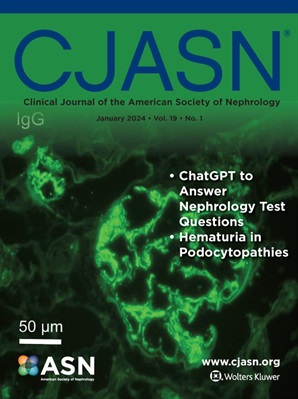基线、早期变化和残余白蛋白尿:达帕格列净治疗慢性肾病临床试验的事后分析
IF 8.5
1区 医学
Q1 UROLOGY & NEPHROLOGY
Clinical Journal of the American Society of Nephrology
Pub Date : 2024-10-17
DOI:10.2215/cjn.0000000000000550
引用次数: 0
摘要
患有或未患有 2 型糖尿病的慢性肾脏病和白蛋白尿患者。方法在这项 DAPA-CKD 试验的事后分析中,4304 名成年 CKD 患者被随机分配到达帕格列净 10 毫克或安慰剂中,作为最大耐受量肾素-血管紧张素系统 (RAAS) 抑制剂的辅助用药。主要终点是估计肾小球滤过率持续下降≥50%、肾衰竭或死于肾脏或心血管原因的复合终点。肾脏综合终点类似,但不包括心血管死亡。我们使用 Cox 比例危险回归分析评估了基线白蛋白尿、白蛋白尿早期变化(基线至第 4 个月)和残留白蛋白尿(第 4 个月)与主要复合终点和肾脏复合终点之间的关系。研究结果与安慰剂相比,达帕格列净可使2型糖尿病患者和非2型糖尿病患者的尿白蛋白与肌酐比值(UACR;基线至第4个月)分别降低36%(95% CI:30.2%,42.5%)和21%(95% CI:12%,30%)(p-交互作用:0.02)。从基线到第 4 个月,UACR 的降低与主要终点和肾脏综合终点风险的降低相关,2 型糖尿病患者和非 2 型糖尿病患者的风险梯度相似(p-交互作用:分别为 0.10 和 0.19)。在每个治疗组中,残留白蛋白尿与主要终点和肾脏综合终点的风险相似(p-交互作用:分别为0.19和0.18)。结论达帕格列净降低了白蛋白尿,而且白蛋白尿降低的幅度显示,2型糖尿病患者和非2型糖尿病患者的主要终点和肾脏综合终点的风险降低比例相似。第4个月时仍有白蛋白尿的患者,无论是随机接受达帕格列净治疗还是安慰剂治疗,其慢性肾功能衰竭进展肾脏终点的发生率都相对较高,这表明可能需要在RAAS抑制剂和达帕格列净治疗的基础上增加其他疗法,以维持肾脏和心血管健康。临床试验登记处名称和登记号:评估达帕格列净对慢性肾脏病患者肾脏预后和心血管死亡率影响的研究(DAPA-CKD),NCT03036150。版权所有 © 2024 作者。由 Wolters Kluwer Health, Inc. 代表美国肾脏病学会出版...本文章由计算机程序翻译,如有差异,请以英文原文为准。
Baseline, Early Changes, and Residual Albuminuria: Post-hoc Analysis of a Clinical Trial of Dapagliflozin in Chronic Kidney Disease
n patients with CKD and albuminuria, with and without type 2 diabetes. Methods: In this post-hoc analysis of the DAPA-CKD trial, 4304 adult patients with CKD were randomized to dapagliflozin 10mg or placebo as adjunct to maximally tolerated renin-angiotensin-system (RAAS) inhibitors. The primary endpoint was a composite of sustained ≥50% decline in estimated glomerular filtration rate, kidney failure, or death from kidney or cardiovascular cause. The kidney composite endpoint was similar but excluded cardiovascular death. We assessed associations among baseline albuminuria, early change in albuminuria, (baseline to Month 4), and residual albuminuria (Month 4) with the primary composite and kidney composite endpoints using Cox proportional hazards regression analyses. Results: Compared to placebo, dapagliflozin reduced urinary albumin-to-creatinine ratio (UACR; baseline to Month 4) by 36% (95% CI: 30.2%, 42.5%) and 21% (95% CI: 12, 30%) in participants with and without type 2 diabetes, respectively (p-interaction: 0.02). A reduction in UACR from baseline to Month 4 was associated with a lower risk for the primary and kidney composite endpoints with a similar risk gradient for participants with and without type 2 diabetes (p-interaction: 0.10 and 0.19, respectively). Residual albuminuria was associated with a similar risk for the primary and kidney composite endpoints in each treatment arm (p-interaction: 0.19 and 0.18, respectively). Conclusions: Dapagliflozin reduced albuminuria, and the magnitude of albuminuria reduction showed similar proportional reductions in risks for the primary and kidney composite endpoints in participants with and without type 2 diabetes. Patients with residual albuminuria at Month 4 – whether randomized to dapagliflozin or placebo – experienced relatively high rates of CKD progression kidney endpoints, suggesting that therapies added to RAAS inhibitors and dapagliflozin may be required to sustain kidney and cardiovascular health. Clinical trial registry name and registration number: A Study to Evaluate the Effect of Dapagliflozin on Renal Outcomes and Cardiovascular Mortality in Patients with Chronic Kidney Disease (DAPA-CKD), NCT03036150. Copyright © 2024 The Author(s). Published by Wolters Kluwer Health, Inc. on behalf of the American Society of Nephrology...
求助全文
通过发布文献求助,成功后即可免费获取论文全文。
去求助
来源期刊
CiteScore
12.20
自引率
3.10%
发文量
514
审稿时长
3-6 weeks
期刊介绍:
The Clinical Journal of the American Society of Nephrology strives to establish itself as the foremost authority in communicating and influencing advances in clinical nephrology by (1) swiftly and effectively disseminating pivotal developments in clinical and translational research in nephrology, encompassing innovations in research methods and care delivery; (2) providing context for these advances in relation to future research directions and patient care; and (3) becoming a key voice on issues with potential implications for the clinical practice of nephrology, particularly within the United States. Original manuscript topics cover a range of areas, including Acid/Base and Electrolyte Disorders, Acute Kidney Injury and ICU Nephrology, Chronic Kidney Disease, Clinical Nephrology, Cystic Kidney Disease, Diabetes and the Kidney, Genetics, Geriatric and Palliative Nephrology, Glomerular and Tubulointerstitial Diseases, Hypertension, Maintenance Dialysis, Mineral Metabolism, Nephrolithiasis, and Transplantation.

 求助内容:
求助内容: 应助结果提醒方式:
应助结果提醒方式:


